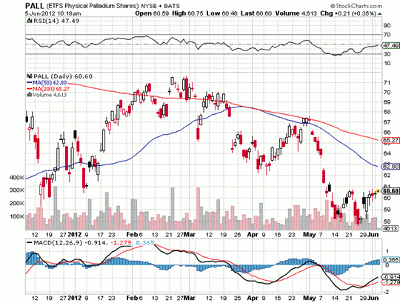Stagnant supply and increasing global demand can drive palladium prices upwards of 65% higher, writes Sterling Wong of Minyanville.com, and there are a few viable ways for investors to play this exciting growth trend.
While gold and silver typically hog commodities headlines, one under-the-radar precious metal with plenty of upside is palladium.
So said North American Palladium (PAL) CFO Jeff Swinoga when he presented at last week’s Euro Pacific Capital investor conference. Swinoga obviously has a vested interest in pushing palladium, but he made sure to back up his claims with evidence.
“The future outlook for palladium is excellent as it continues to benefit from positive supply and demand fundamentals,” he said.
Currently, the global mine supply of palladium is about 6.8 million ounces worldwide, with most of it coming from Russia and South Africa. In North America, Stillwater Mining (SWC) and North American Palladium (PAL) are the big guns of palladium mining.
Swinoga points out that an increase in palladium supply does not look likely.
“In South Africa, there are issues associated with unions, the tax structure they’re putting in place, infrastructure problems, and the electricity price increases [power utility] Eskom is putting in place. A lot of South African companies now are in fact talking about curtailing their production in order to save their balance sheets.”
“You’ve [also] got declining palladium production in Russia. There are no new mines that I’m aware of on the horizon,” said Swinoga, who added that the CPM Group projected for palladium production going forward to be “relatively flat.”
The other remaining supply of palladium is a Russian stockpile from the Cold War era, which reached about 18-20 million ounces. Back in the 1980s, Russia believed it required palladium for cold fusion. However, Swinoga explained that the country started selling off palladium over time when it realized that cold fusion does not really work. The stockpile contributed about one million ounces in the market in the last two years, he said.
“The good news is that that stockpile as far as we and others are aware, is gone. That the stockpile is not significant anymore is going to be a game changer, with prices being able to rise since then,” Swinoga asserted.
While palladium supply will likely stagnate, demand for the metal is only going to increase, with the primary driver continuing to be the automotive sector, which currently consumes about 60% of world palladium production.
Palladium is used in catalytic converters for gasoline engines, and as Swinoga noted, the growth of car demand in BRIC countries as citizens there get increasingly affluent will only push palladium demand up.
“Credible forecasters such as IHS predict that global vehicle production will increase from about 77 million units to about 100 million units by 2016. Most of that growth is coming from the BRIC economies. China represents about 18 million vehicles per year, but it’s going to rise to about 30 to 40 million vehicles per year by the year 2020,” he said.
“It makes sense. In North America, there are about 700 vehicles per 1,000 people. In China, it’s about 70 vehicles per 1,000 people right now, so there’s lots of room for growth on a per capita basis.”
As BRIC countries further industrialize, they have also gotten increasingly tougher on emission standards. That means a greater need for catalytic converters, and therefore, an increased demand for palladium.
Besides industrial demand, there has also been a rise in investment demand for palladium, Swinoga said. Palladium ETFs, which have only been around since 2007, are now trading in Zurich, London, Japan, and on the NYSE.
There is a total of about two million ounces of palladium in ETFs such as the ETFS Physical Palladium Shares (PALL)…:
…And the ETFS White Metals Basket Trust (WITE):
“Our view is that supply is going to stagnate, and demand is continuing to grow for the reasons that we talked about: vehicle use and investment demand,” summed up Swinoga.
“In terms of price forecasts, both TD Bank and BNP Paribas see the price going over $1,000. Today, palladium is at around $615, so there is lots of room for growth.”
By Sterling Wong, contributor, Minyanville.com





















